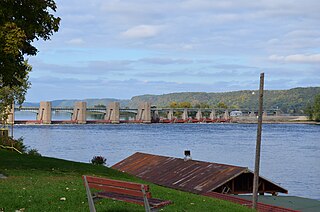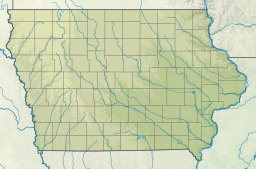
The Mississippi River is the primary river, and second-longest river, of the largest drainage basin in the United States. From its traditional source of Lake Itasca in northern Minnesota, it flows generally south for 2,340 miles (3,766 km) to the Mississippi River Delta in the Gulf of Mexico. With its many tributaries, the Mississippi's watershed drains all or parts of 32 U.S. states and two Canadian provinces between the Rocky and Appalachian mountains. The main stem is entirely within the United States; the total drainage basin is 1,151,000 sq mi (2,980,000 km2), of which only about one percent is in Canada. The Mississippi ranks as the thirteenth-largest river by discharge in the world. The river either borders or passes through the states of Minnesota, Wisconsin, Iowa, Illinois, Missouri, Kentucky, Tennessee, Arkansas, Mississippi, and Louisiana.

The Great River Road is a collection of state and local roads that follow the course of the Mississippi River through ten states of the United States. They are Minnesota, Wisconsin, Iowa, Illinois, Missouri, Kentucky, Tennessee, Arkansas, Mississippi and Louisiana. It formerly extended north into Canada, serving the provinces of Ontario and Manitoba. The road is designated as both a National Scenic Byway and an All-American Road in several states along the route.

Houston County is a county in the U.S. state of Minnesota. At the 2020 census, the population was 18,843. Its county seat is Caledonia.

Allamakee County is the northeasternmost county in the U.S. state of Iowa. As of the 2020 census, the population was 14,061. Its county seat is Waukon.

Guttenberg is a city in Clayton County, Iowa, United States, along the Mississippi River. The population was 1,817 at the time of the 2020 census, down from 1,987 at the 2000 census.

The Driftless Area, also known as Bluff Country, the Blufflands, the Paleozoic Plateau, and the Coulee Region, is a topographical and cultural region in the Midwestern United States that comprises southwestern Wisconsin, southeastern Minnesota, northeastern Iowa, and the extreme northwestern corner of Illinois. The Driftless Area is a USDA Level III Ecoregion: Ecoregion 52. The Driftless Area takes up a large portion of the Upper Midwest forest–savanna transition.
Buffalo Creek may refer to:

Lock and Dam No. 10 is a lock and dam located in Guttenberg, Iowa on the Upper Mississippi River around river mile 615.0. It was constructed and placed in operation November 1937. The site underwent major rehabilitation 1989—2006. The dam consists of a concrete dam 763 feet (232.6 m) long with four roller gates and eight tainter gates. The earth embankment is 4,223 feet (1,287.2 m) long with a concrete spillway 1,200 feet (365.8 m) long. The lock is 110 feet (33.5 m) wide by 600 feet (182.9 m) long. The lock and dam are owned and operated by the St. Paul District of the United States Army Corps of Engineers-Mississippi Valley Division.

U.S. Highway 52 is a 166-mile-long (267 km) United States Numbered Highway in northeast Iowa. The route begins at the Dale Gardner Veterans Memorial Bridge over the Mississippi River between Sabula and Savanna, Illinois. From Sabula, it heads north along the Mississippi towards Bellevue and Dubuque. At Dubuque, US 52 briefly shares an expressway with US 61 and US 151 before joining the Southwest Arterial, another expressway diverting traffic around the southern edge of Dubuque.

Lake Winneshiek is the name given to that portion of Navigation Pool 9 impounded by Lock and Dam No. 9 between the dam to 4 miles south of the city of Lansing, Iowa on the Upper Mississippi River, near Ferryville, Wisconsin. It encompasses about 6,000 acres (24 km²) and is part of the Upper Mississippi River National Wildlife and Fish Refuge. The Army Corps of Engineers has proposed constructing some islands in the lake in order to improve wildlife habitat.

Buck Creek is a small tributary of the Upper Mississippi River flowing mainly through Garnavillo and Jefferson Townnships in Clayton County, Iowa, to join the Big River at Bussey Lake, a backwater lake approximately two miles above Lock and Dam No. 10 at Guttenberg, Iowa. The Army Corps of Engineers is working to reduce erosion problems in the creek's drainage.

The Turkey River is a 153-mile-long (246 km) tributary of the upper Mississippi River. Its main branch rises in Howard County, Iowa, near the city of Cresco. The other counties it or its tributaries cover are Chickasaw, Winneshiek, Fayette, Clayton, Delaware, and Dubuque. Tributaries include the Little Turkey River and Crane Creek.

Big Lake is an open body of water surrounded by marshy islands in Navigation Pool 9 of the Upper Mississippi River. It lies where the Iowa, Minnesota and Wisconsin borders come together, just north of Lansing, Iowa. It is part of the Upper Mississippi River National Wildlife and Fish Refuge.

The Upper Iowa Conference is a high school athletic conference in Iowa made up of 1A and 2A schools in northeastern Iowa. It is currently a nine team league. It has the current sports: volleyball, boys and girls basketball, golf, cross country, boys and girls track and field, baseball, softball, and wrestling. Clayton Ridge, North Fayette Valley and Postville compete in soccer.

The Lakeside Ballroom, also known as the Lakeside Pavilion, is a historic building located in Guttenberg, Iowa, United States. It is located next to the Mississippi River near a backwater known as Bussey Lake. The first part of the building was completed in 1927 by local contractor Louis Schroeder for $17,000. William (Bill) Kann Sr. had the facility built as the Lakeside Pavilion, and it was operated by two of his sons, Edmund and William Jr. They sold the building in 1935 and it was expanded and converted into a ballroom. Many local and national music acts performed at Lakeside, including: Jesse Stone, Jimmy Wade, Wayne King and their orchestras.

The Guttenberg National Fish Hatchery and Aquarium Historic District is a nationally recognized historic district located in Guttenberg, Iowa, United States. It was listed on the National Register of Historic Places in 1991. At the time of its nomination the district consisted of four resources, all of which are contributing buildings. This district also contributes to the Front Street Historic District. The U.S. Fish and Wildlife Service had a long history of involvement with wildlife conservation in Iowa, especially fisheries. They established fish rescue program along the Mississippi River in 1903 and a research station at Fairport in 1910. The development of the lock and dam system in the 1930s brought the fish rescue operations to an end because they eliminated of the backwaters that trapped them. The fish hatchery was developed at that time.


















